Complete Tanzania Safari Guide: 9-Day Itinerary (2025)
This complete Tanzania safari guide covers our 9-day itinerary through Serengeti, Ngorongoro Crater, and Tarangire, including detailed costs, accommodation reviews, and practical planning tips for first-time safari travelers.
Table of Contents
- The Moment That Changed Everything
- Why Choose Tanzania for Safari: Timing and Parks
- Complete 9-Day Tanzania Safari Itinerary
- Tanzania Safari Camps & Arusha Hotels Review
- Tanzania Safari Planning Guide: Costs & Tips
- Safari Highlights & Essential Reading
The Moment That Changed Everything
I thought I knew what to expect from an African safari. I’d seen the documentaries: lions hunting at dawn, elephants moving in slow processions, vast golden plains stretching toward distant horizons. And yes—all of that happens exactly as you’ve seen on screen.
But standing there in the Serengeti, watching three lionesses coordinate their hunt on a family of warthogs, I realized how utterly unprepared I was for the reality of safari. I’d seen this exact scene in countless documentaries, but witnessing it unfold in real life—the strategic positioning, the explosive chase, the successful kill, and then four lion cubs emerging from nowhere to join the feast—left me speechless.
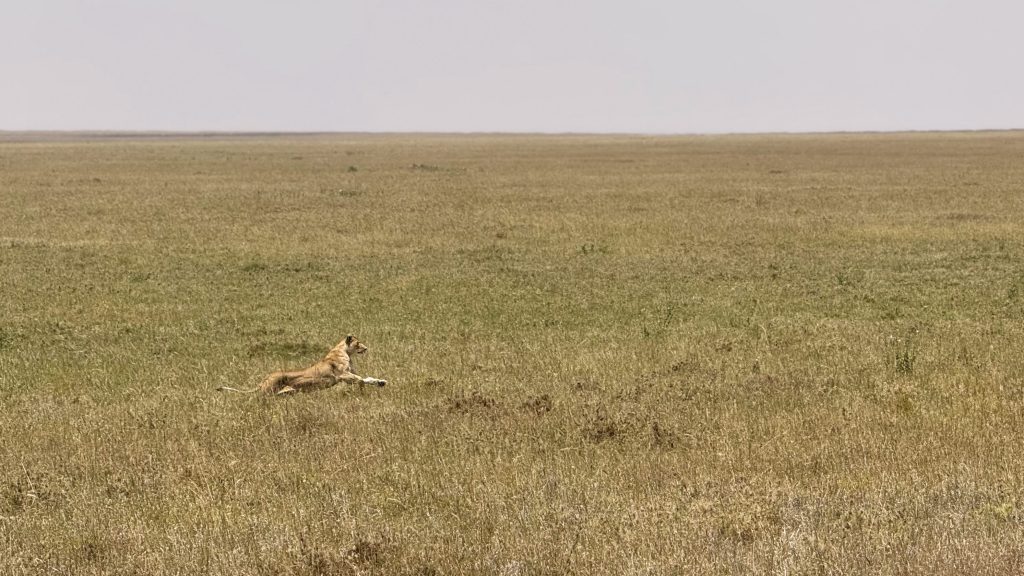
Lioness hunting
The Great Migration isn’t a neat frame of animals moving in orderly lines either; it spills in every direction until the horizon blurs, a living river of wildebeest and zebra that seems to stretch into infinity.
The scale of this land is unspeakable, almost disorienting, like staring into deep time itself.
What struck me most was how unfiltered it all is. There’s no narrator explaining what you’re seeing, no background music swelling at dramatic moments. Just wind, dust, and life playing out as it always has, indifferent to your presence yet somehow welcoming you into its ancient rhythm. You’re inside it, part of the ecosystem for these precious few days, learning firsthand how cruel nature can be, but also how absolutely magnificent.
A lot to reflect on from our animal friends, as it turns out.
But getting to this life-changing moment required months of planning, countless decisions, and more than a few leaps of faith.
Why Choose Tanzania for Safari: Timing and Parks
For our first African adventure, my friends and I had two non-negotiables: we wanted to witness the Great Migration’s dramatic river crossings, and as devoted cat lovers with small cats at home, we’re absolutely obsessed with big cats. These priorities immediately narrowed our focus to East Africa, specifically Kenya or Tanzania—the twin hearts of safari country where the wildebeest migration creates one of nature’s most spectacular shows.

Lion couple resting
Between these two incredible destinations, Tanzania won our hearts for several compelling reasons. The parks here are larger, more diverse, and crucially, less crowded than their Kenyan counterparts. With two weeks carved out of our busy lives and no desire to rush through this once-in-a-lifetime experience, Tanzania’s more spacious, wilderness-focused approach felt perfect for what we wanted: immersion, not just observation.
Timing: The Art of Chasing Migration
The Great Migration follows ancient patterns, but it’s not as predictable as a train schedule. Wildebeest migrate in a huge loop between Tanzania’s Serengeti and Kenya’s Masai Mara, tracking the rains and the fresh green pastures they create. River crossings happen between July and October—the herds cross north into Kenya, stay for 3-4 weeks, and cross south back into Tanzania.
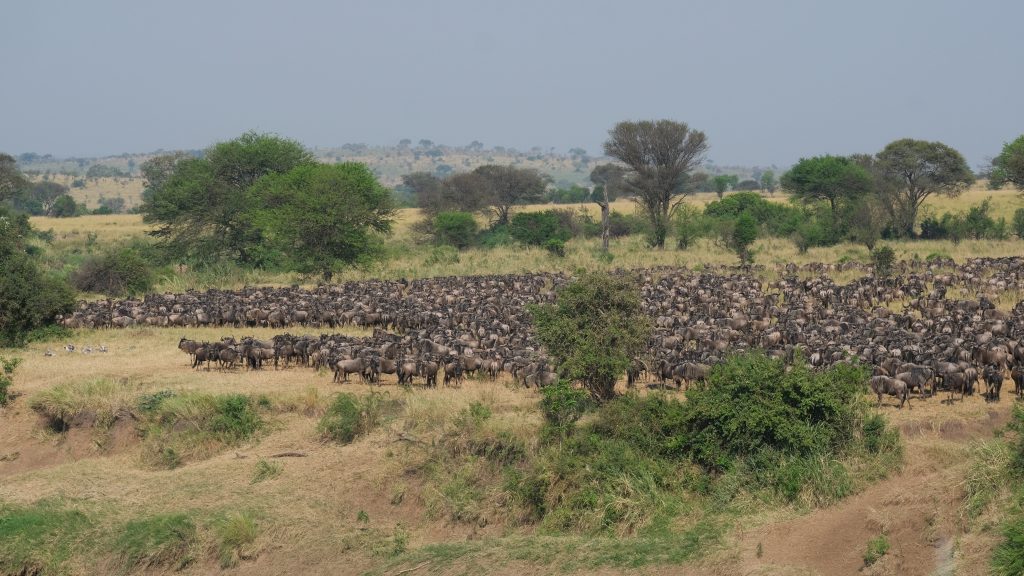
Wildebeest herd waiting before crossing river
We chose early September around Labor Day weekend simply because it worked with our schedules—any time within the migration season would have given us great chances for dramatic crossings. This timing also coincides with dry season, when the grass turns golden, water becomes precious, and animals congregate near predictable water sources, making them easier to spot. Plus, fewer mosquitoes to contend with.

Cheetah posing
Planning Tip: There’s another excellent window between January and March (February especially) that coincides with calving season. According to our guide, this is when wildebeest drop babies every single day, creating different but equally spectacular viewing opportunities.
Our Park Choices
We decided to focus on Tanzania’s northern circuit: Serengeti for the migration and big cats, Ngorongoro Crater for its incredible wildlife density, and Tarangire for its distinctive baobab landscapes and peaceful atmosphere. Each promised a completely different ecosystem and experience—exactly the variety we wanted for our first African adventure.
The decision felt right from the moment we committed to it. Tanzania promised variety, space to breathe, and the wilderness experience we craved. Looking back after nine transformative days, I can say with confidence: we chose perfectly.
Complete 9-Day Tanzania Safari Itinerary
Ngorongoro: First Taste of Africa
Day 1: Arrival at the Rim
After a 9 AM departure from Arusha, we drove through bustling towns like Mto-Wa-Mbu (where fish, bananas, and vegetables lined the roadside markets) and Karatu (with its German colonial coffee plantations). Our guide Isack showed solid driving skills navigating the various roads, though we hadn’t yet discovered just how talented he truly was.
We stopped for lunch from our packed lunch boxes, encountered our first African wildlife—a family of baboons that had us snapping photos excitedly—and passed through police checkpoints and park registration before reaching Ngorongoro’s rim around 3 PM.
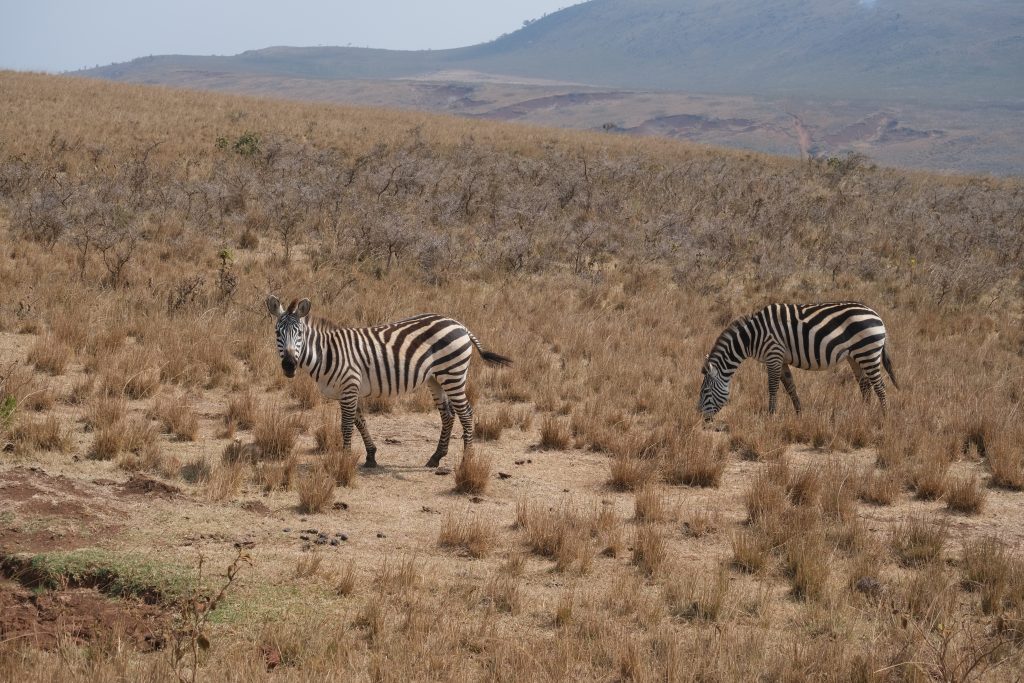
Zebras grazing
The rim offered our first glimpse into the crater below, but mostly we spent the afternoon settling into Mysigio Camp, taking a short walk with a Maasai guide to see zebras, goats, and cows herded by Maasai in their iconic red scarves. A quiet, restful day to ease into safari life.
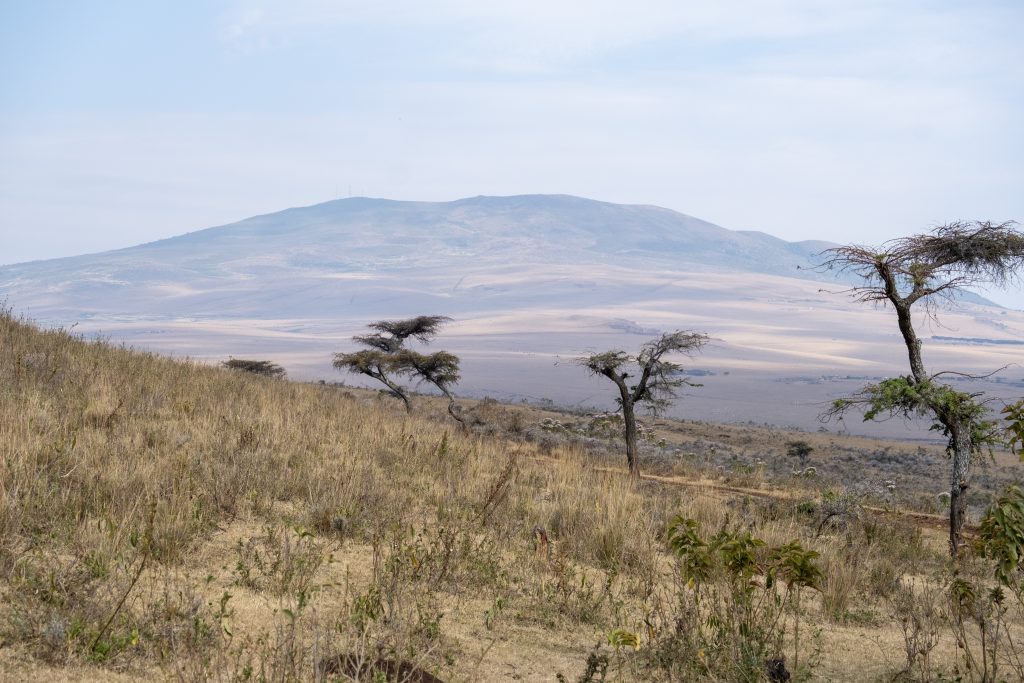
Landscape – Hiking near Mysigio Camp
Day 2: “Big Five” – Ngorongoro Game Drive
At 6:40 AM—our earliest start of the trip—we descended through thick fog, worried about visibility. But after passing registration around 7:20 AM and dropping below the rim, the weather cleared completely.
What struck me immediately was the dramatic landscape change and the incredible wildlife density.
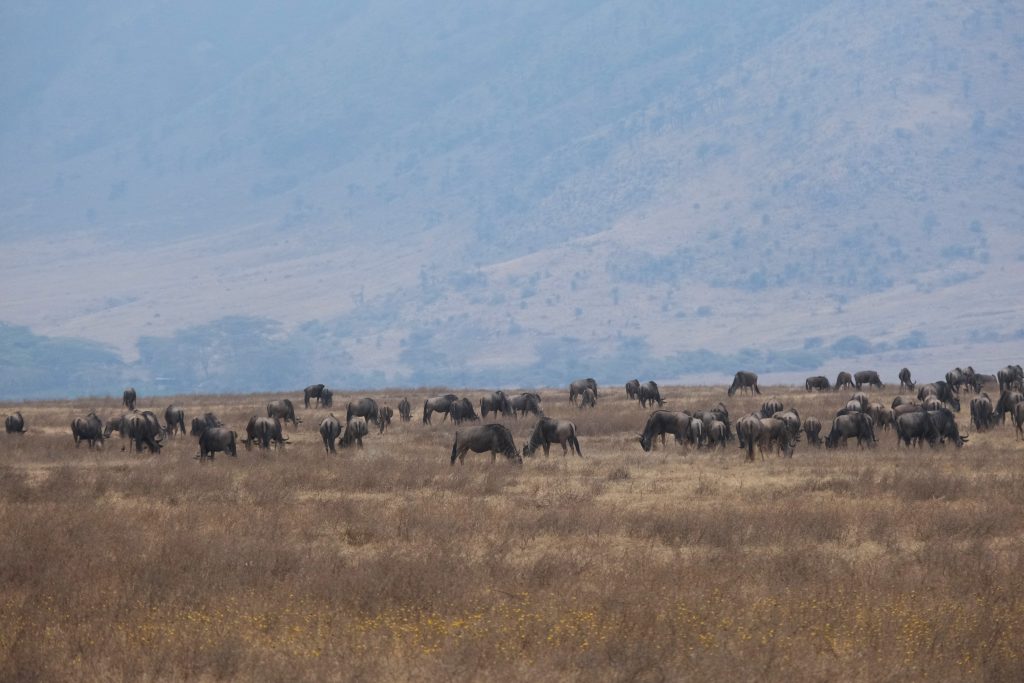
Wildebeest herd grazing w/ crater wall backdrop
Within hours, we encountered ostriches, lions lounging under trees, hippos in muddy pools, flamingos (both lesser and greater species) painting the soda lake pink, hartebeest, grey crowned cranes, buffalo, hyenas, kori bustards, and warthogs.

Lion walking towards his brother
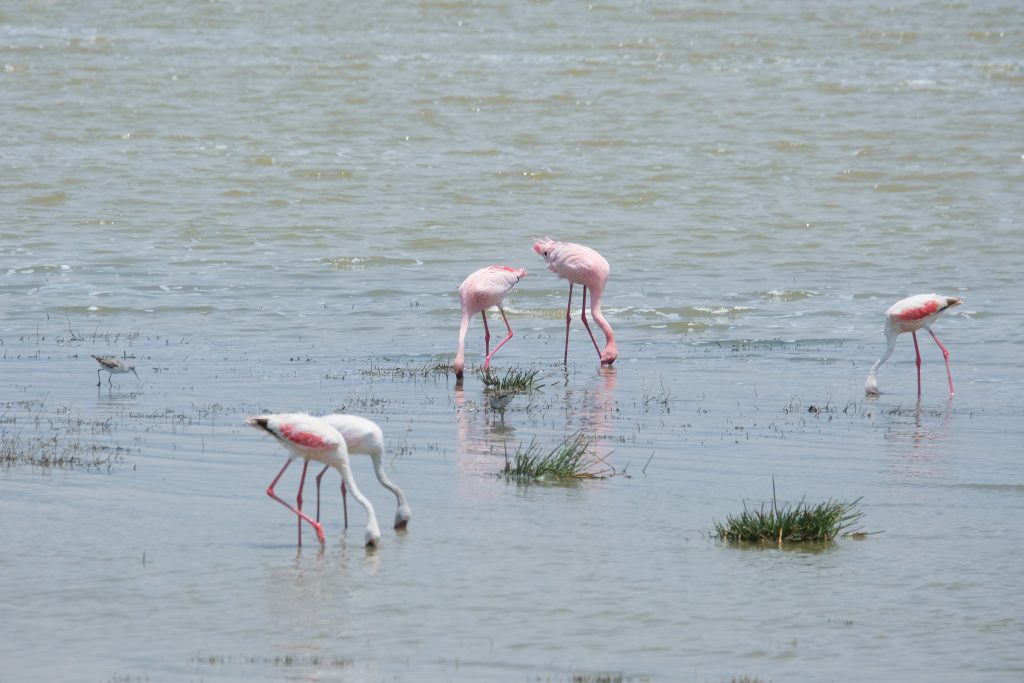
Lesser flamingos and greater flamingos foraging in the soda lake

Grey crowned cranes foraging
But it was the leopard—relaxed and napping on a tree—that truly amazed me. Seeing this elusive cat so calm and accessible felt like a gift. We also spotted a black rhino in the distance and had lunch at the hippo pool, where these massive animals yawned and grunted just meters from our picnic spot.
Timing Tip: Starting early made all the difference. Ngorongoro only allows one guided path, so later arrivals face crowds, but at 7 AM we had most sightings to ourselves.
That evening, local Maasai school children performed traditional dances—our first real cultural exchange and a joyful end to an incredible day.
Serengeti: Where Dreams Come Alive
Day 3: “Lion Kill” – Ngorongoro to Northern Serengeti
What we planned as a travel day became one of our most memorable. Soon after entering Serengeti, we spotted cheetahs—a mother with two cubs resting under acacia trees.
Then came the moment that defines this entire trip for me: three lionesses executing their hunt with perfect coordination. We watched them position strategically, explode into their chase, successfully bring down one of three warthogs, and then gasped as four lion cubs appeared from nowhere to join the feast. Seeing this iconic scene—familiar from countless documentaries—unfold in real life left me completely speechless.

Four cubs sitting still while their mama on the mission of warthog hunt
Lionesses chasing warthogs
We also encountered an African wildcat, more elephants, our first giraffes (though Isack just shrugged—”they’re everywhere”), topis, hartebeests, wildebeests, buffalo, secretary birds, ostriches, and a single hyena scavenging a wildebeest carcass while vultures waited patiently nearby.

“All is mine!”
This extended game drive meant we watched sunset from our vehicle, arriving at Intimate Zebra Camp at 8 PM after light rain. Nobody complained—days like this are exactly why you come to Africa.
Day 4: “River Crossing” – Northern Serengeti Game Day
Walking to breakfast around 7:15 AM, staff stopped us to point out a family of elephants casually hanging around camp—apparently normal, but magical for us.
We headed northwest to the Mara River, where a small herd of wildebeest stood hesitating on the north bank. Moving to site 0A (apparently that’s the insider code), we found the main event: hundreds of wildebeest gathered and agitated.
Within half an hour, one brave wildebeest made the decision. The crossing began—hundreds streaming across in desperate urgency.
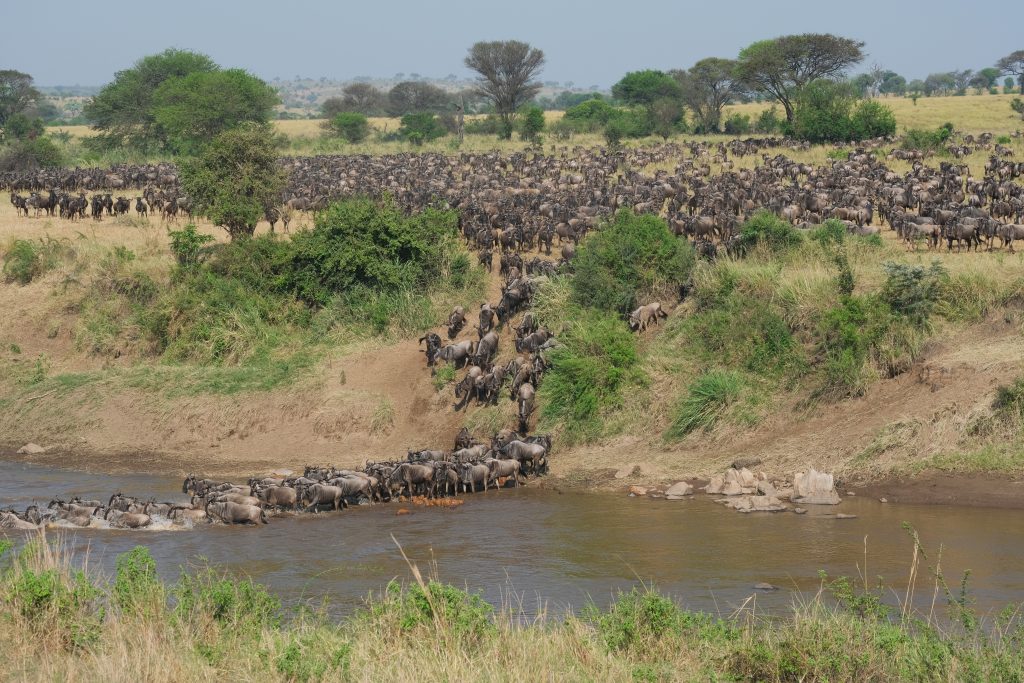
Wildebeest crossing Mara river
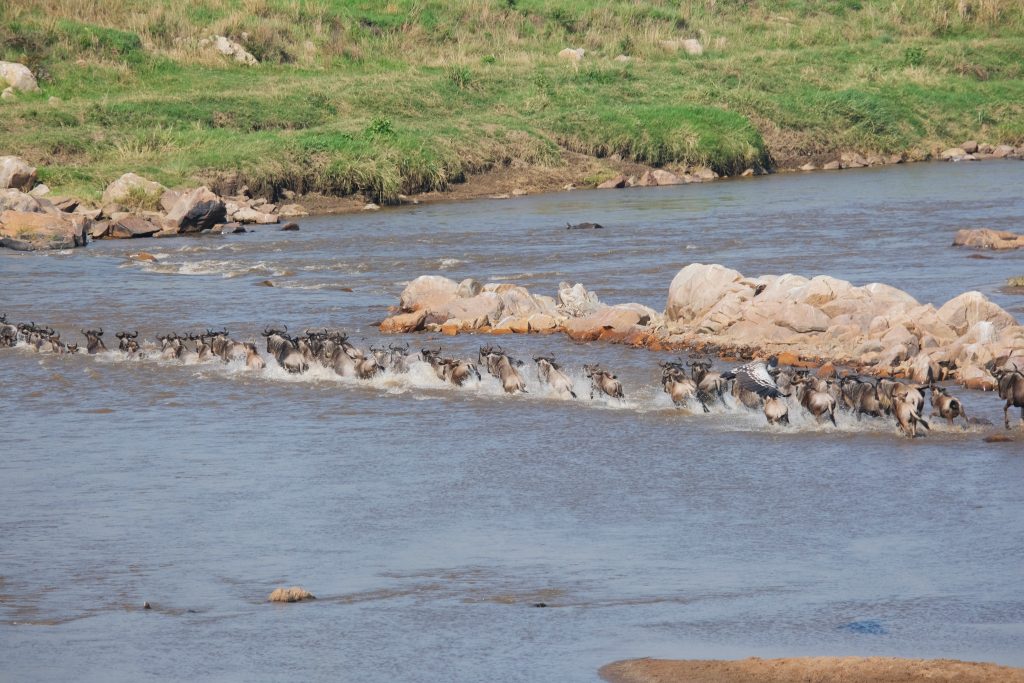
Wildebeest running for life
Then crocodiles struck, killing one wildebeest and causing the herd to panic and divert to a new crossing path. But even this diversion couldn’t calm their fears, and suddenly the entire crossing stopped.
The drama continued when juvenile wildebeest who had successfully crossed found themselves separated from their families. Their distressed calling echoed across the river as they tried to encourage adults to cross and reunite. With no response, these youngsters carefully navigated back through crocodile-infested waters to rejoin their mothers.
We spent the rest of the day along the river, seeing several wildebeest bodies near rocks, crocodiles, vultures, marabou storks, and different hippos (larger species than in Ngorongoro).

Wildebeest bodies and scavengers
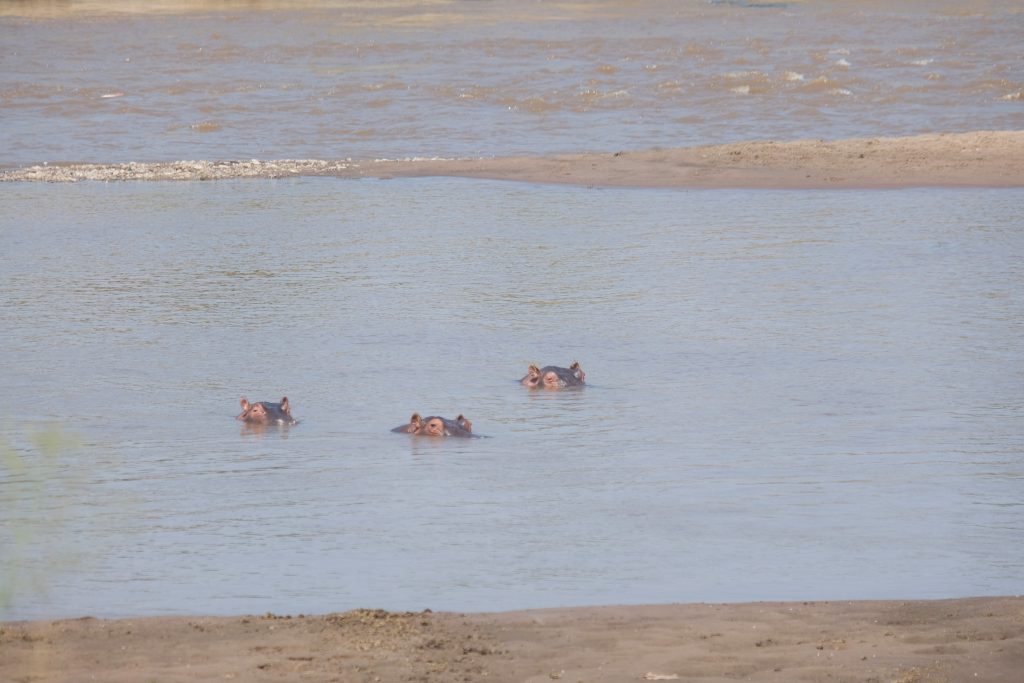
Common hippos “onsen” time
We also saw our second leopard—a young adult female originally napping on a tree, but disturbed by a family of baboons and chased into bushes before running away. Along the river, we encountered topis, impalas, elephants, warthogs, and dwarf mongoose for the first time.
Day 5: “Migration” – Northern to Central Serengeti
Departing at 9 AM for central Serengeti, we witnessed the migration’s true scale. Large herds of wildebeest and smaller zebra groups were moving north—Isack explained recent southern rains had confused them to migrate south, but now they were getting back toward the Mara River.
The scale was unbelievable. Hundreds of thousands of animals stretched to every horizon, an ancient dance between wildlife and weather patterns that felt truly primordial.

Wildebeest migration
Among the masses, we spotted more giraffes (including an albino one), elephant families, impala herds, warthog families, buffaloes, and baboon families. For cats, we saw seven lions total—a pride napping and drinking water, plus a young male who failed to impress anyone and sulked away to relieve himself nearby. We also encountered two cheetahs resting under trees.
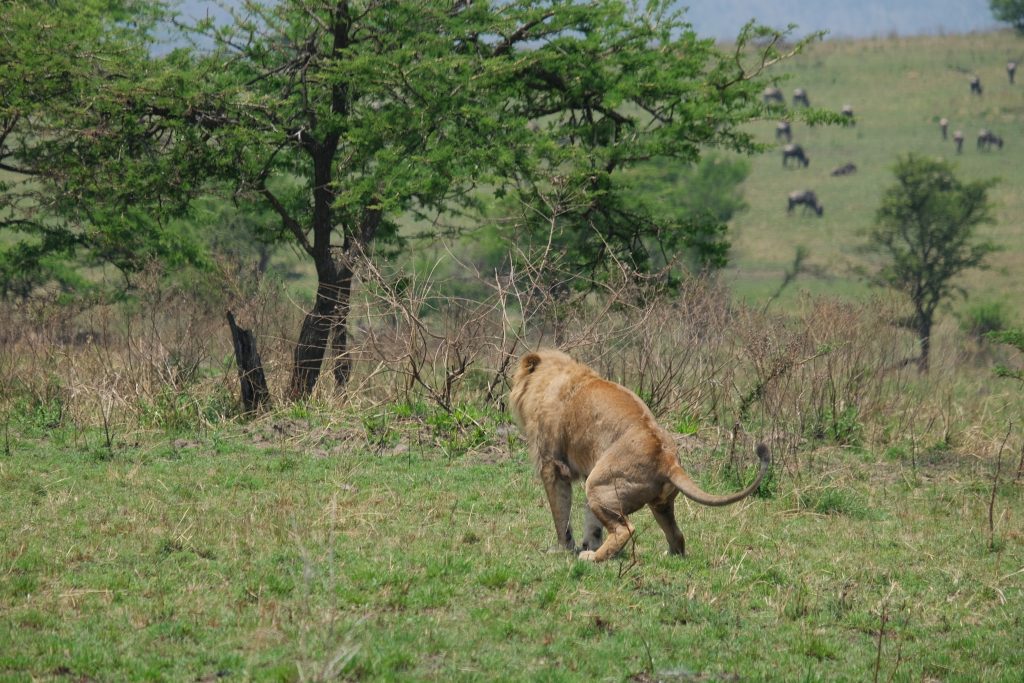
“Good view and plenty of food”

Two male cheetahs resting under the tree
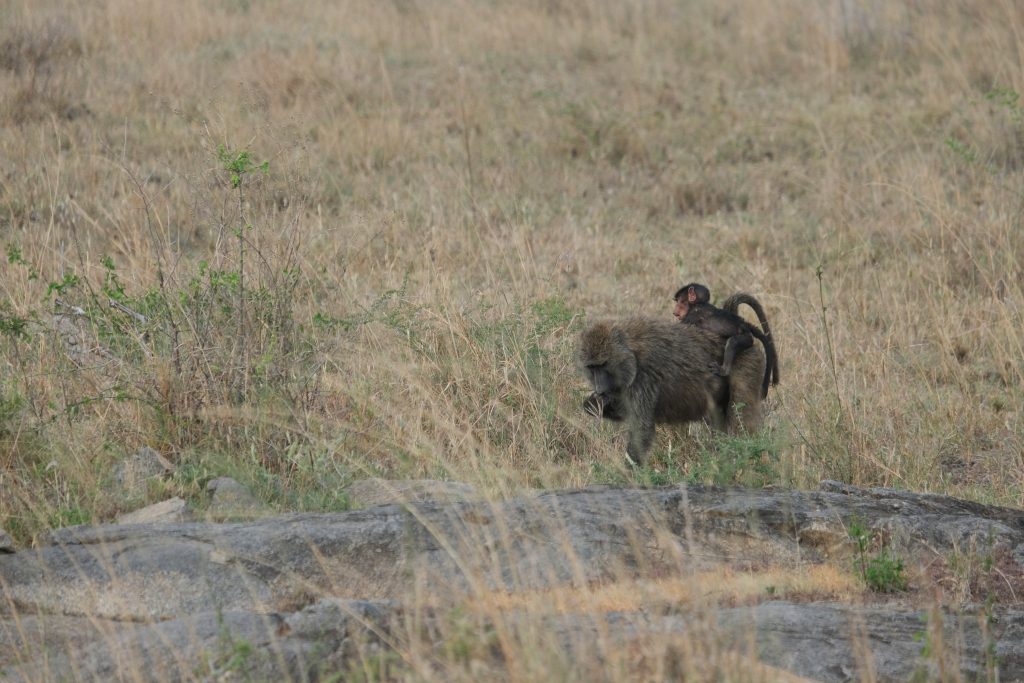
Baby baboon struggled to hold tight of mama’s back
That night featured a full lunar eclipse clearly visible through binoculars while lion roars echoed around our camp. Staff escorts were mandatory between tents and common areas—we were literally sleeping in lion territory.
Day 6: “Cats Day” – Central Serengeti Game Drive
Central Serengeti lived up to its big cat reputation. After heading southeast from camp, we immediately started seeing lions and lionesses. We also got a close-up photo of a young male leopard napping in a tree, and observed a serval cat executing its textbook high-jump hunting style to catch a rat.
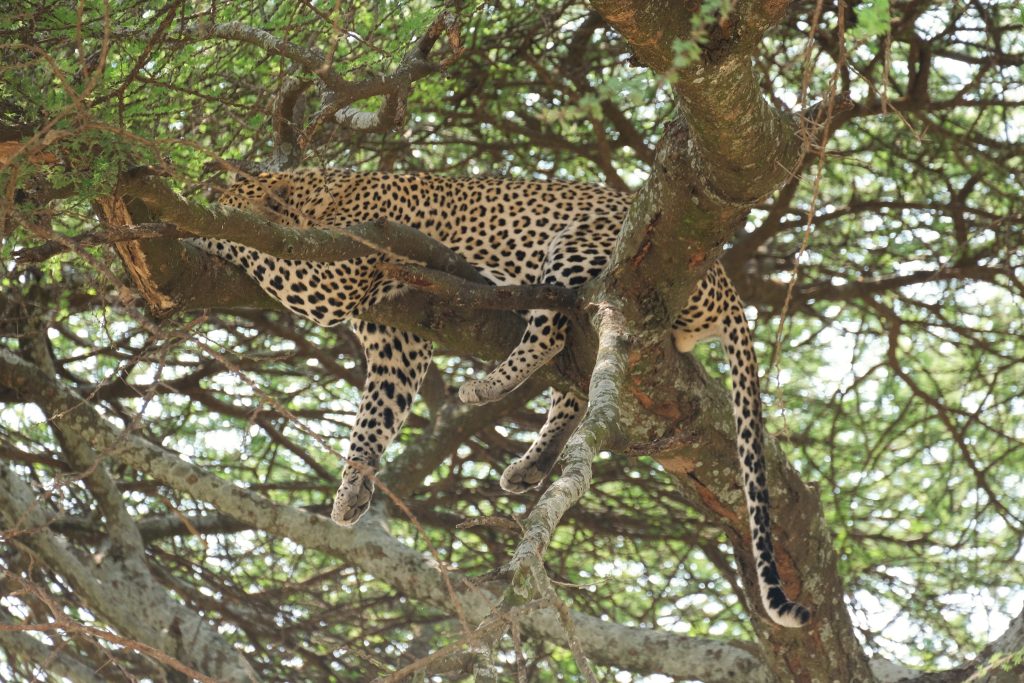
Young male leopard napping in a tree
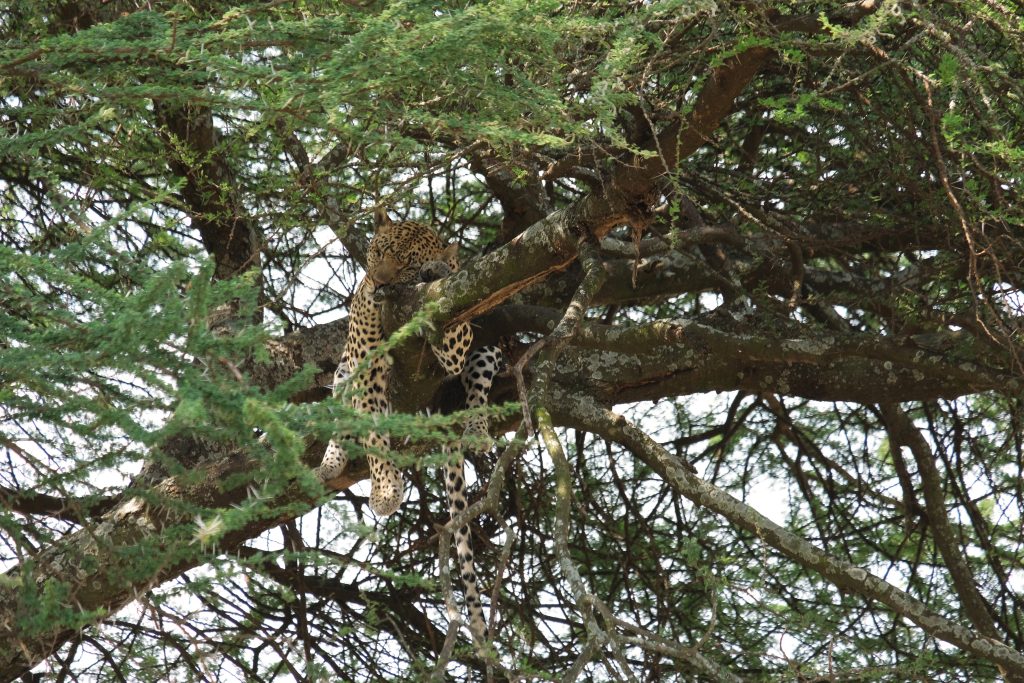
Seemed comfortable

Serval cat!
We also saw warthogs, female hyena packs, gazelles (the whole herd standing motionless facing into wind while one individual played guardian), a lost baby topi, hyrax (amazingly, these rabbit-sized creatures are elephants’ closest relatives), reedbuck herds, dik-diks, hippos, impalas, giraffes (including a baby less than a week old still carrying its umbilical cord), vervet monkeys, and countless bird species.

Gazelle herd standing motionless
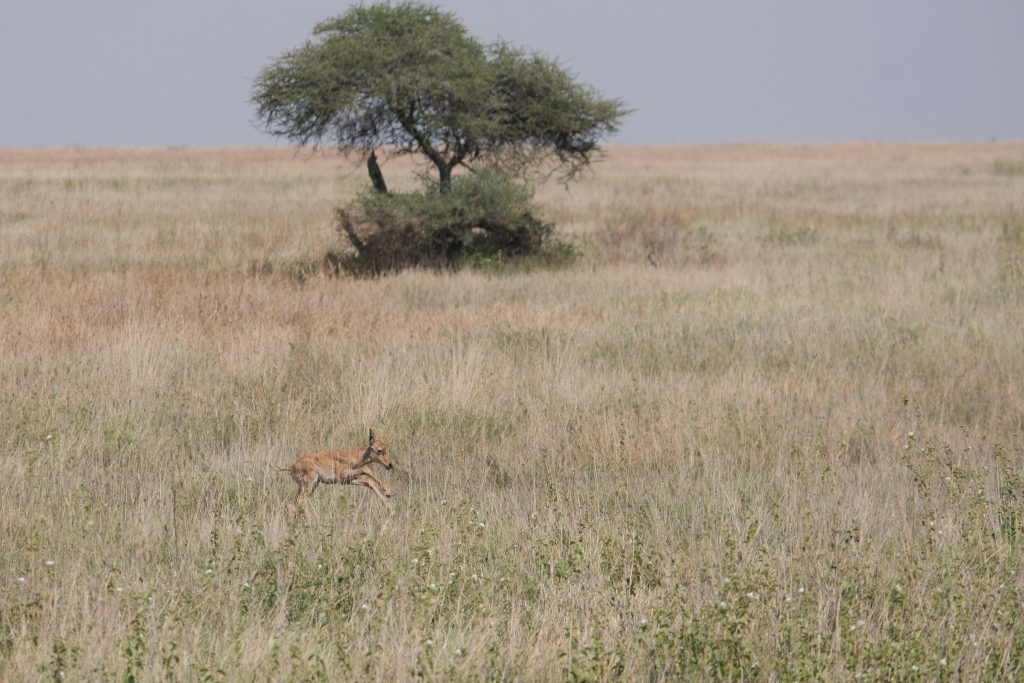
The lost baby topi could barely run
Tarangire: The Peaceful Finale
Day 7: “Baobab Trees” – Central Serengeti to Tarangire
Nyumbani camp’s location offered stunning sunrise views with nothing blocking the horizon—we watched a beautiful dawn from our tent. There was a hyena kill right before departure that we missed.
Heading south, we encountered a couple of jackals, warthogs, and hyenas before meeting another vehicle with bad news: the road ahead was destroyed by rain. We followed their detour recommendation, then stopped to help when their car broke down. Isack diagnosed the problem, helped fix it, and finalized the repair with a good old-fashioned push—our first glimpse of his mechanical skills beyond driving.
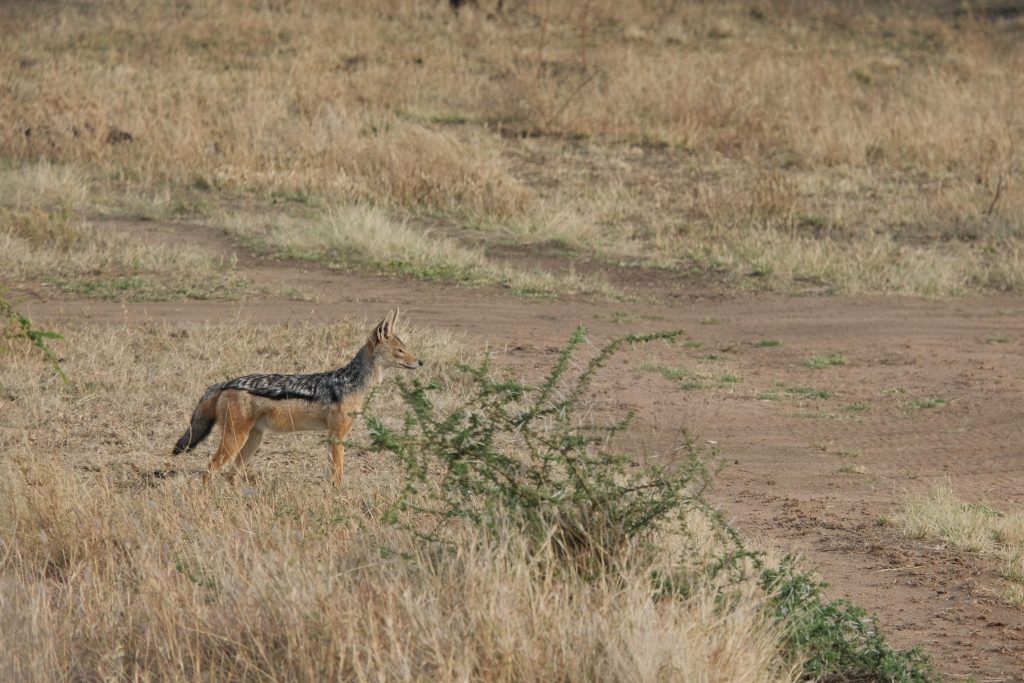
Black-backed jackal
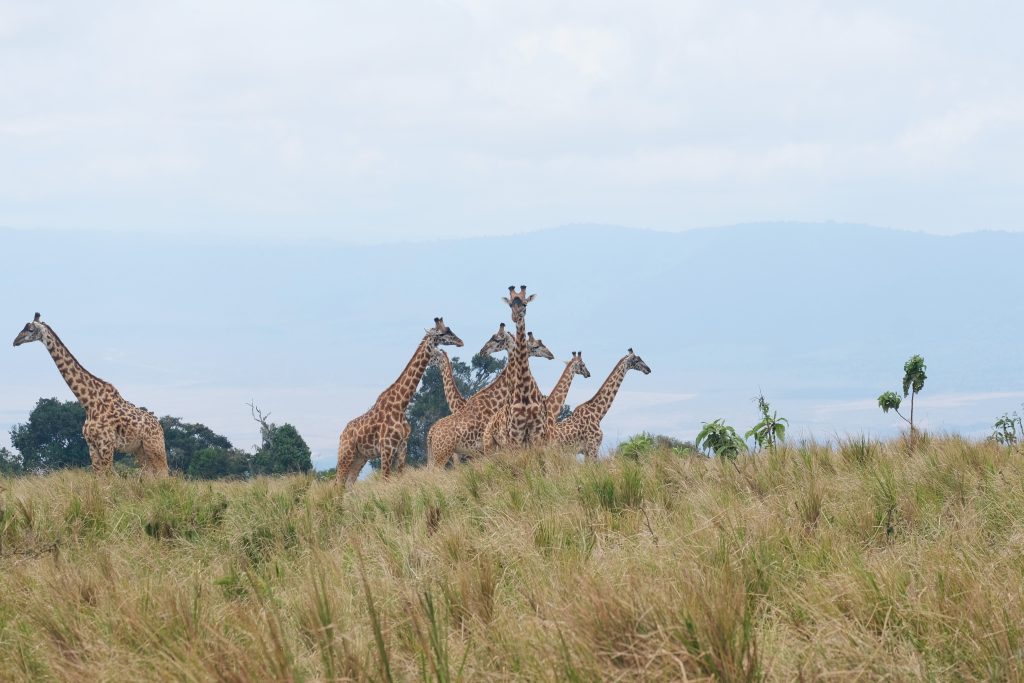
Tower of giraffe bachelors
After seeing more hartebeests and giraffes, we exited Serengeti, refueled, had lunch, and headed to Tarangire. At the gate, several massive baobab trees marked the park’s identity, and the landscape immediately transformed. Termite mounds dotted the scenery, enormous baobab trees (still bare of leaves) created otherworldly shapes, and we noticed the animals’ different coloration—wildebeest appeared paler for camouflage, as did warthogs and ostriches.
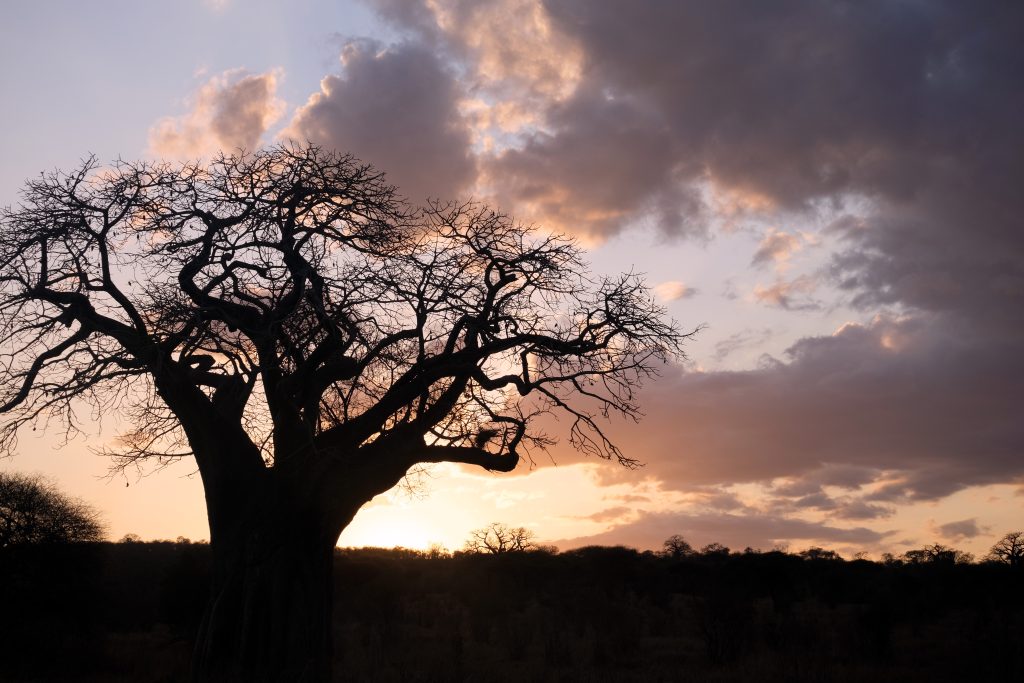
Sunset & Baobab tree
We spotted elands, banded mongoose running and standing in perfect synchronization, elephants, Zebras enjoyed “bird therapy” with small birds perching on their backs picking off insects, and another young female leopard in a tree, arriving at Tarangire View Camp right at sunset. The camp used permanent wooden cabins instead of tents—spacious, clean, and comfortable.

This zebra loved it
Day 8: “Peaceful Life” – Tarangire Game Day
The animal coloration differences were even more apparent in daylight—warthogs more orange, ostriches rustier, wildebeest paler, all adapted for Tarangire’s specific environment. Termite mounds and baobab trees dominated the landscape.
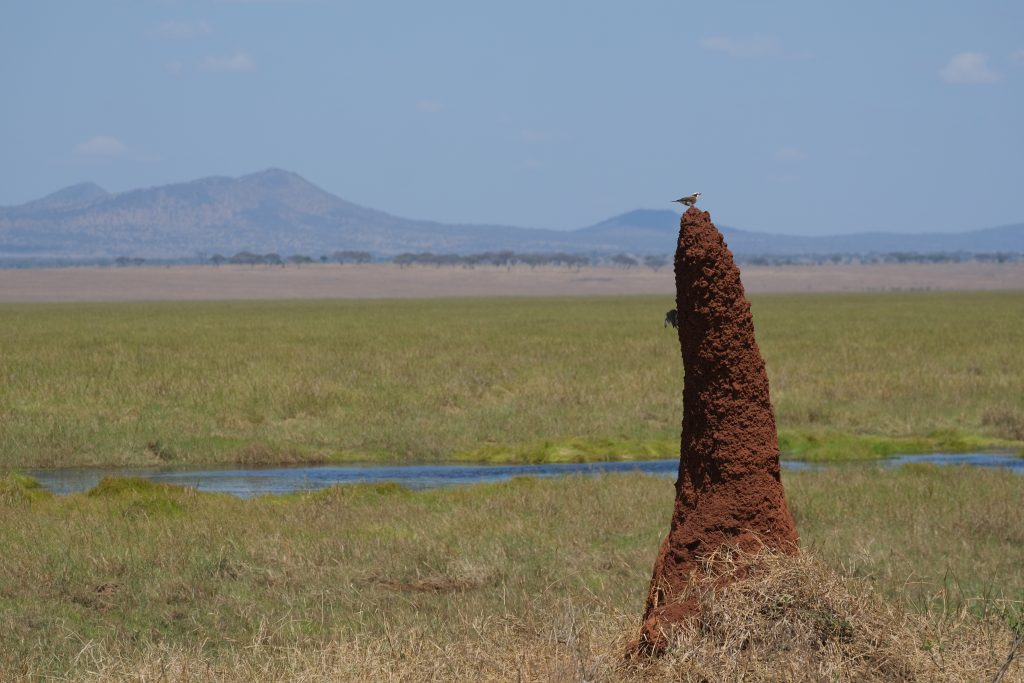
Birds standing on termite mound
We found another herd of dwarf mongoose and encountered our lions for the day: first three females with full bellies lounging by the river, then a separated male and female who began mating—quite a show.
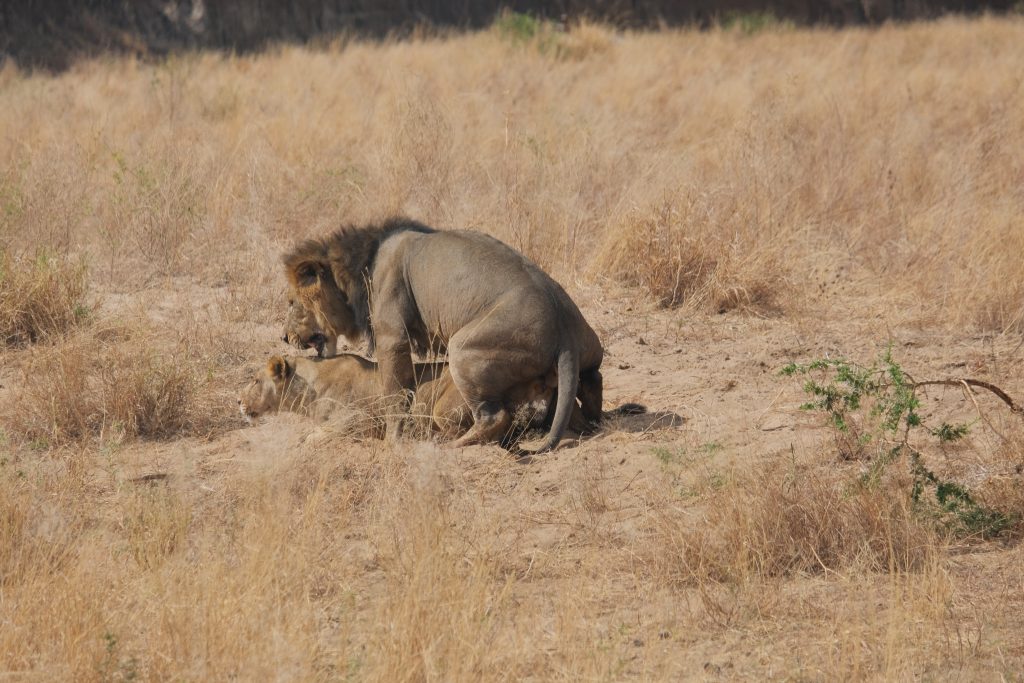
Lion mating
Following the road south to Salale Swamp’s west bank, we discovered the most peaceful spot of our entire trip. With fewer predators here, life moved at a gentler pace. Zebras rolled over for mud baths. Elephants congregated around the swamp in large groups, taking luxurious mud showers.
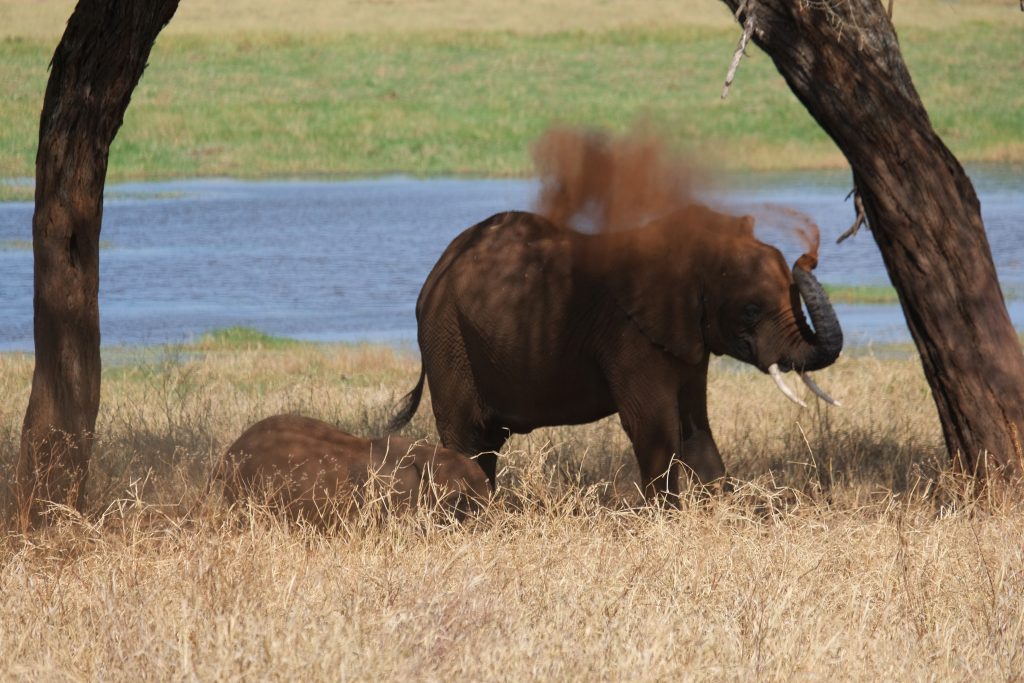
Young elephant mama taking mud shower
A pregnant warthog foraged along the bank while white-faced whistling ducks paddled by—a scene so perfectly composed it looked animated. We also spotted waterbucks and numerous bird species in this serene environment where baobab trees were less dense than other areas of the park.
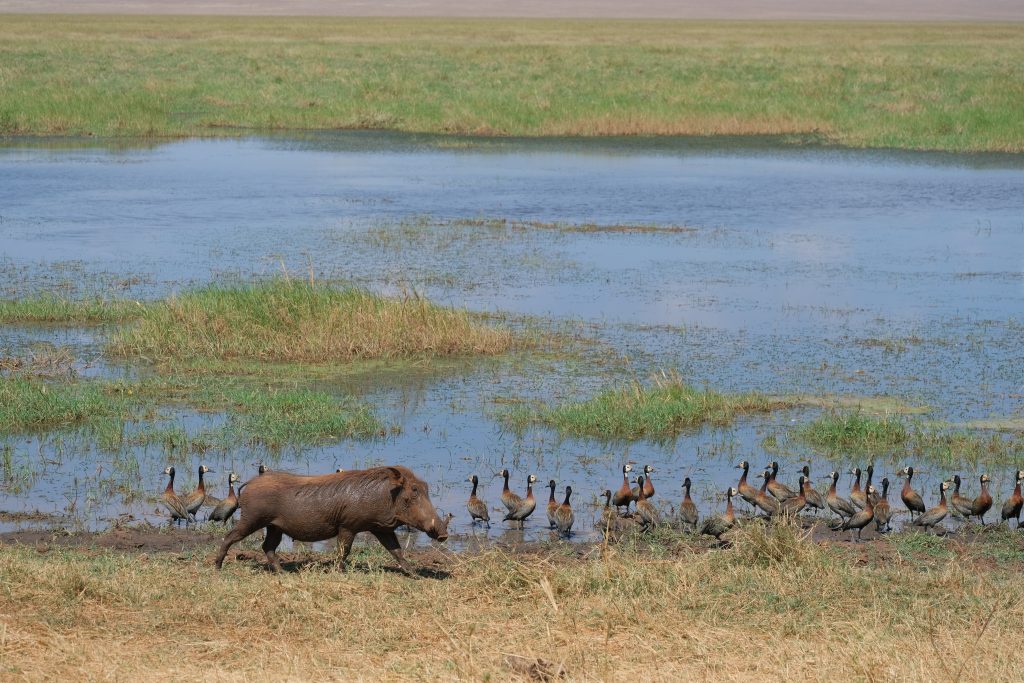
Warthog mama foraging along the bank
During our game drive, another vehicle got stuck in sand. Isack quickly helped pull them out—another demonstration of his resourcefulness and community spirit among guides.
Day 9: Tarangire Short Game Drive & Back to Arusha
For our final morning, we took it easy since we’d seen so much already. The highlight was witnessing two ostriches mating—exactly as awkward and fascinating as you’d imagine.
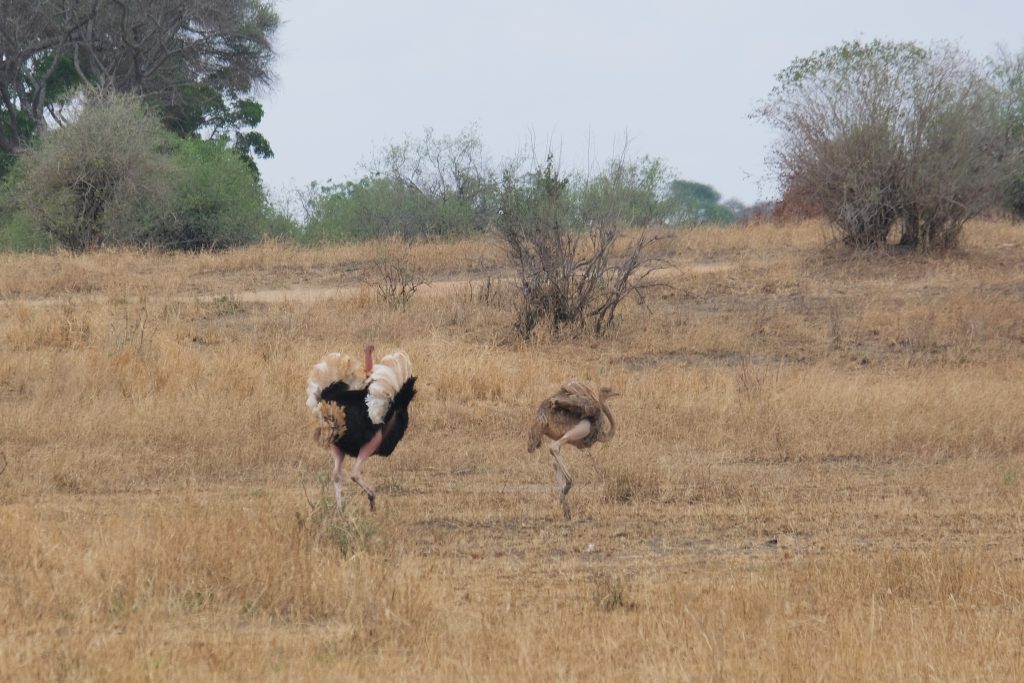
Male ostrich’s display right before mating
More elephants, zebras, vervet monkeys climbing termite mounds, and giraffes browsing acacia trees filled our last few hours. We had lunch at the gate at noon, then headed to Shoki Shoki Lodge in Arusha, arriving around 3:30 PM.
As we drove away from the parks toward civilization, we had time to process everything we’d experienced—and start planning our inevitable return to this incredible country.
Tanzania Safari Camps & Arusha Hotels Review
What Safari Camps Look Like
Mysigio Camp (Ngorongoro – 2 nights)
Location: Outside the crater rim with minimal views
Accommodation: Tents with queen or twin beds, private shower and bathroom inside. Hot water manually uploaded by staff (they’ll wait outside if you need more)
Amenities: No tap water in tents; drinkable water provided. Phone/camera charging only in dining area
Food: Excellent, especially the Spanish omelet
Staff: Friendly camp manager with good English, though rarely present. Maasai staff very genuine and attentive despite limited English
Experience: Good overall. Maasai walk was interesting, and school children performed traditional dances. However, we expected more intimate cultural exchange with Maasai families that didn’t materialize. We also lost some cash here—bring money with you at all times
Distance to common areas: Very close, no escort needed
[Update Oct ’25: After pointing out the differences between what we were told to expect and what actually happened, Stacy – the owner of our tour operator – contacted Mysigio Camp and got us a refund of $85 per person. We still wish we’d been able to join the Orpul Ceremony (the traditional goat barbecue), but I really appreciated the way Stacy handled things and made it right.]
Intimate Zebra Camp (Northern Serengeti – 2 nights)
Location: Mobile camp near Mara River, perfect for river crossings. Great savanna views with elephants passing by in mornings
Accommodation: Spacious tents. Queen rooms well-designed; triple rooms awkwardly laid out. Private shower/bathroom inside
Amenities: Non-drinkable tap water available; bottled drinking water provided separately. Phone/camera charging in tents
Food: Standard buffet style Staff: Friendly with good English
Experience: Good overall with no complaints. Free laundry service was a nice bonus
Distance to common areas: 3-4 minute walk. Daytime walking fine; escort required after dark
Nyumbani Camp (Central Serengeti – 2 nights)
Location: Permanent camp near kopjes where lions sometimes appear. Stunning savanna views with beautiful sunrises/sunsets. Buffalo spotted in evenings. We witnessed the lunar eclipse here
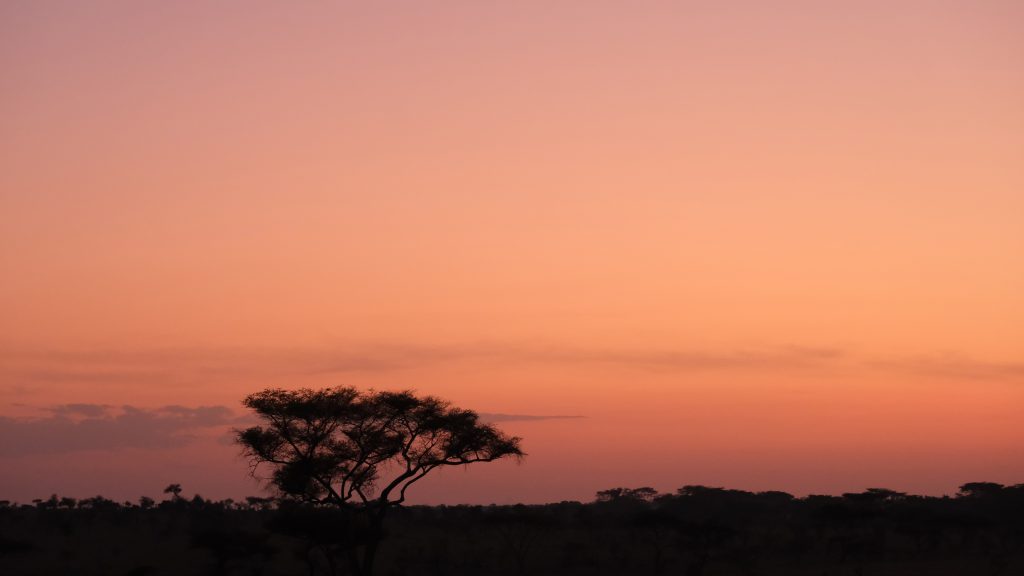
Twilight shot outside of tent
Accommodation: Very spacious. Queen rooms excellent with sofas; triple rooms poorly designed. Private shower/bathroom inside
Amenities: Non-drinkable tap water; bottled drinking water provided. Phone/camera charging in tents
Food: Excellent dinner service, especially starters and soups
Staff: Attentive and friendly but sometimes intrusive. When bath heater broke, staff sincerely apologized and brought hot water buckets. Camp manager was problematic – full of excuses and stories instead of honest communication about issues
[Update Oct ’25: Stacy also reached out to the owner of Nymbani Camp after reading my feedback, which I really appreciated. To clarify what I meant by “sometimes intrusive”: as four introverts, we occasionally felt our quiet lounge time turned into longer chats than we wanted. The staff were wonderfully kind and attentive—it just sometimes felt like there was an expectation to socialize when we were hoping for downtime.]
Experience: Overall enjoyed our stay despite management issues. Extremely comfortable rooms with incredible surroundings
Distance to common areas: 5-6 minute walk. Escort required at all times due to predator presence
Tarangire View Camp (Tarangire – 2 nights)
Location: Permanent camp inside Tarangire with wooden buildings instead of tents. Zebras visited in evenings
Accommodation: Extremely spacious rooms with excellent layouts for both queen and twin configurations. Private shower/bathroom
Amenities: Non-drinkable tap water; bottled drinking water provided. Phone charging in rooms; cameras charge in common areas
Food: Standard quality, served style
Staff: Very friendly with excellent English. Respectful and gave appropriate space. Many female staff members. Genuine apologies for any small mistakes. Camp manager was authentic and hilarious
Experience: Our favorite camp. Comfortable, well-managed, and great service
Distance to common areas: 6-8 minute walk (mini-hike). Daytime walking allowed 7 AM-7 PM; escort required after dark
Camp Selection Note: You typically won’t choose specific camps—different agencies work with different properties. This information helps set expectations for what safari camp life looks like.
Arusha Accommodation Reviews
Sanna Boutique Hotel (Pre-safari – 2 nights)
Overall feel: Standard 3-star hotel—clean and organized but nothing fancy
Location: Downtown Arusha, walking distance to cafes and restaurants. 20 minutes from Arusha Airport, 1 hour 20 minutes from JRO Airport. 10 minutes drive to Cultural Heritage Center
Rooms: Clean and spacious—almost too big
Food: Standard quality—good but not amazing
Service: Friendly, helpful staff; offers airport pick-up/send-off service
Views: City views from rooms; rooftop offers good sunrise views and Mount Meru sightings
Facilities: Fitness center, spa, massage available (we didn’t try them)
Check availabilities at Sanna Boutique Hotel
Shoki Shoki Lodge (Post-safari – 1 night)
Overall feel: Vacation home atmosphere offering privacy and relaxation
Location: Slightly outside absolute center but easily accessible. Quieter, residential feel. 15 minutes from Arusha Airport, 1 hour 15 minutes to JRO Airport
Rooms: We shared a private suite with spacious lounge/kitchen, queen bedroom, twin bedroom, and small outdoor pool. Extremely comfortable—we didn’t want to leave
Food: Excellent dinner served to suite; basic takeout breakfast
Service: Sweet, friendly, helpful staff; offers airport pick-up/send-off service
Check availabilities at Shoki Shoki Lodge
Tanzania Safari Planning Guide: Costs & Tips
Itinerary Planning: The Foundation
The most important decisions revolve around where you want to go and how to structure your time. For us: three parks, four locations, two nights each. This approach worked perfectly because it gave us dramatically different ecosystems while allowing full game drive days from each base and minimizing packing stress.
What Parks We Chose vs. What We Skipped
What We Chose and Why
Serengeti National Park was non-negotiable. We came for the Great Migration and river crossings, which meant Serengeti was essential. It exceeded every expectation—not just meeting our migration goals but delivering incredible big cat encounters, diverse landscapes from kopjes to endless plains, and that indescribable sense of witnessing something truly ancient and wild.
Ngorongoro Crater made our list for several reasons: it’s the world’s largest intact caldera offering unique landscapes, we had serious flamingo lovers in our group, and as a conservation area (not national park) with Maasai communities, it offered cultural experiences alongside wildlife. The crater delivered all “Big Five” animals including rare black rhinos, unique soda lake ecosystems, and remarkable wildlife density. Yes, it gets crowded since only one path is allowed, but starting early minimized this issue.
Tarangire National Park became our surprise favorite. Initially chosen because a friend wished she’d spent more time there and our agency owner called it her favorite park, Tarangire offered everything we loved: stunning baobab landscapes, peaceful swamp areas, massive elephant populations, and comfortable facilities. The scale and variety of baobab trees were mind-blowing, and the relaxed atmosphere near Salale Swamp provided perfect contrast to Serengeti’s intensity.
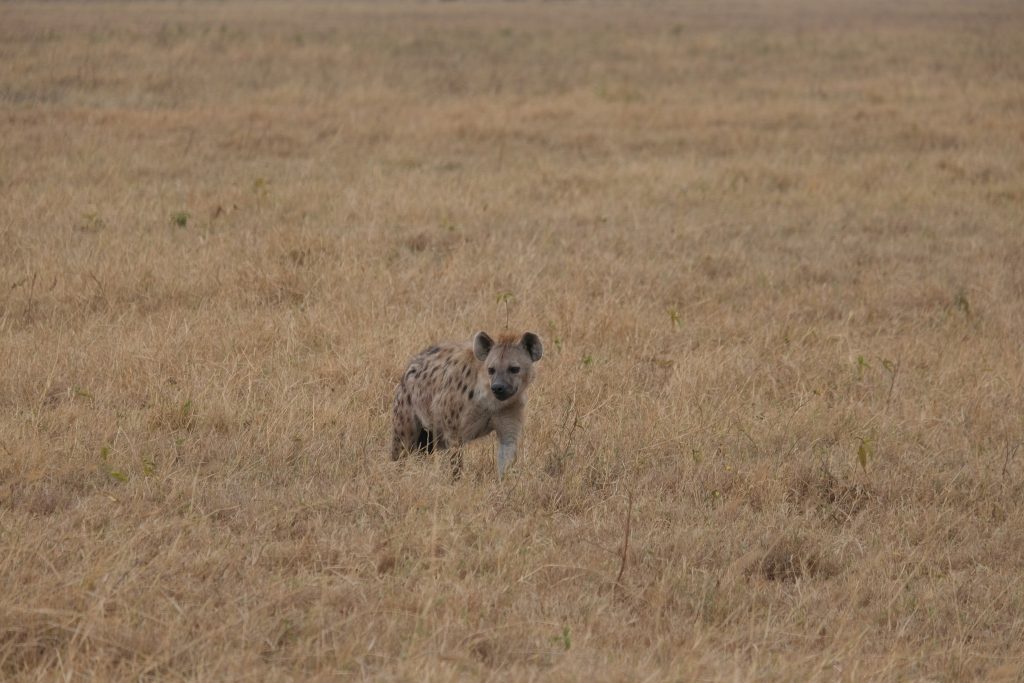
Male hyena @Ngorongoro
What We Skipped and Why
Mount Kilimanjaro/Mount Meru hiking: With two weeks total and nine days already dedicated to safari, adding multi-day hikes felt overwhelming. Even as hiking enthusiasts, we agreed this wasn’t a hiking trip—it was a safari trip.
Shira Plateau day hike: Though I seriously considered this option for Kilimanjaro views, our non-hiking friends might not enjoy two days of logistics for one hike, and the 11,500-foot elevation could be uncomfortable without acclimatization. Since I struggle with altitude and our safari didn’t require acclimatization, we ultimately skipped it.
Lake Natron: Famous for lesser flamingos and waterfall hikes, Lake Natron appealed to me for two nights. However, I didn’t want to rush our trip with constant movement. Our agent also mentioned you must walk quite far to reach flamingos, whereas Ngorongoro allows close vehicle access. We got excellent flamingo viewing in Ngorongoro without regret, though I did miss the reportedly amazing waterfall hike.
Lake Manyara National Park: Reviews indicated dramatically decreased flamingo populations in recent years, and with so many famous parks already packed into our schedule, we skipped it without much hesitation.
Travel Operator Selection
I started planning in November and sent emails to agencies recommended by friends and Reddit users before finalizing my choice in February. We had a great experience with Duma Explorer, and our guide Isack proved exceptional with 20+ years of experience. He excelled at spotting animals, reading behavior, following subtle clues, and handling mechanical problems that came up with other vehicles.
Honestly, choosing a safari operator feels like a gamble – you’re investing significant money based largely on promises and reviews. I’m sure there are other excellent operators out there, but I can only speak to our experience, which was outstanding.
Group Size & Vehicle Considerations
Vehicle and guide costs are shared among group members, so larger groups mean lower per-person costs. When I quoted, four people cost roughly $500-800 more per person than six people groups.
However, Toyota Land Cruiser 4x4s get crowded with six or seven people plus luggage. Wildlife spotting can also become challenging when everyone’s trying to photograph the same leopard through limited windows.
We found four people perfect—enough to share costs reasonably while maintaining comfort and good viewing opportunities for everyone.
Our closed-door Toyota Land Cruiser proved dusty enough even with small window gaps during Serengeti drives—I can’t imagine the dust levels in open-sided vehicles. More importantly, we witnessed a male lion get triggered by a passing vehicle right after mating and run toward that car. Closed doors simply felt safer in such situations.
Practical Essentials
Logistics: Visas, Vaccines, Meds & Weather
Visas: We obtained e-visas online before departure. Customs at JRO airport was straightforward—no additional questions asked.
Vaccines: No yellow fever vaccine required as of September 2025 (check CDC website for current requirements). We all took malaria pills starting 1-2 days before travel through seven days after return.
Additional medications: We took DEET insect repellent and anti-itch cream, both of which proved useful. We brought stomach upset remedies but luckily didn’t need them.
Weather (September):
- Ngorongoro: Cool mornings/evenings, hot during day
- Serengeti: Pleasant mornings/evenings, hot during day
- Tarangire: Pleasant mornings/evenings, hot during day
Packing for Success
Think summer hiking clothes with maximum sun protection:
Essential Clothing:
- Sun hoodies/long-sleeve shirts
- Long pants (thin fabric better than shorts for sun/bite protection)
- Sun jacket with hood for morning/evening vehicle time
- Warmer hoodie/jacket for early morning or late evening
- Crocs or slip-on shoes for easy on/off in safari vehicles
- Neck gaiters (sun and dust protection)
- Full-rim sun hat
- Quality sunglasses
Gear & Equipment:
- Documents (passport, visa, etc.)
- Cash (USD and Tanzanian Shillings)
- Travel-sized toiletries (some camps provide minimal amenities)
- Binoculars (guides typically carry two sets, but personal ones are better)
- Camera with extra batteries and memory cards (300mm+ lens recommended for close-ups; I used 50-230mm on APS-C sensor successfully)
- DEET or Picaridin insect repellent
- Sunscreen and eye drops
- Wet wipes and snacks
- Day pack for game drives
Budget Reality Check
Package costs: $3,000-5,000 per person, depending on accommodation level and group size
Tipping expectations:
- Guide: suggested $30-50+/day per vehicle, depending on the service
- Camp staff: $10/night per person
Transportation:
- International flights: $1,100 from SFO via Turkish Airlines
- JRO Airport ↔ Arusha: $50-70 per vehicle
- Arusha Airport ↔ Arusha: $18-30 per vehicle
- Cultural Heritage Center round trip: $40
Additional costs:
- Arusha dinners: $10-20 per person
- Local beer: $3-5 per bottle (Serengeti is tasty!)
- Vaccines/medications: $200+ (varies by location and insurance)
Cultural Considerations
Languages: Tanzania recognizes Swahili and English. Most guides and lodge staff speak excellent English, while locals communicate in Swahili.
Useful Swahili phrases:
- Jambo (Hello)
- Asante (Thank you)
- Karibu (You’re welcome)
Tipping culture: Expected for guides and camp staff. USD is widely accepted. Agencies typically provide specific guidance.
Your Own Preferences Matter Most
Your perfect safari depends on your priorities:
- What animals excite you most? Big cats, elephants, birds, or rare species?
- What landscapes appeal to you? Endless plains, crater floors, baobab forests, or mountain views?
- How do you prefer to travel? Flying between parks or driving overland?
- What’s your ideal pace? Maximum wildlife variety or deeper exploration of fewer areas?
- Do you want cultural experiences alongside wildlife viewing?
The key is honest communication with your chosen agency about what matters most to your group, then together craft an itinerary that delivers your priorities within your budget and timeline.
Safari Highlights & Essential Reading
Safari Highlights: What Made This Trip Extraordinary
The sheer volume and variety of wildlife encounters over nine days were mind-blowing. We witnessed 46 lions, 10 cheetahs, and 5 leopards in their natural behaviors—not just resting, but hunting, mating, playing, and interacting with their environment.
The dramatic moments included that unforgettable lion kill where three lionesses coordinated their hunt and four cubs joined the feast, lions mating in Tarangire, crocodiles striking during river crossings, and a serval cat executing its textbook high-jump hunting technique. We watched warthogs running for their lives, giraffes engaging in slow-motion fights, and hyenas scavenging carcasses while vultures waited patiently nearby.
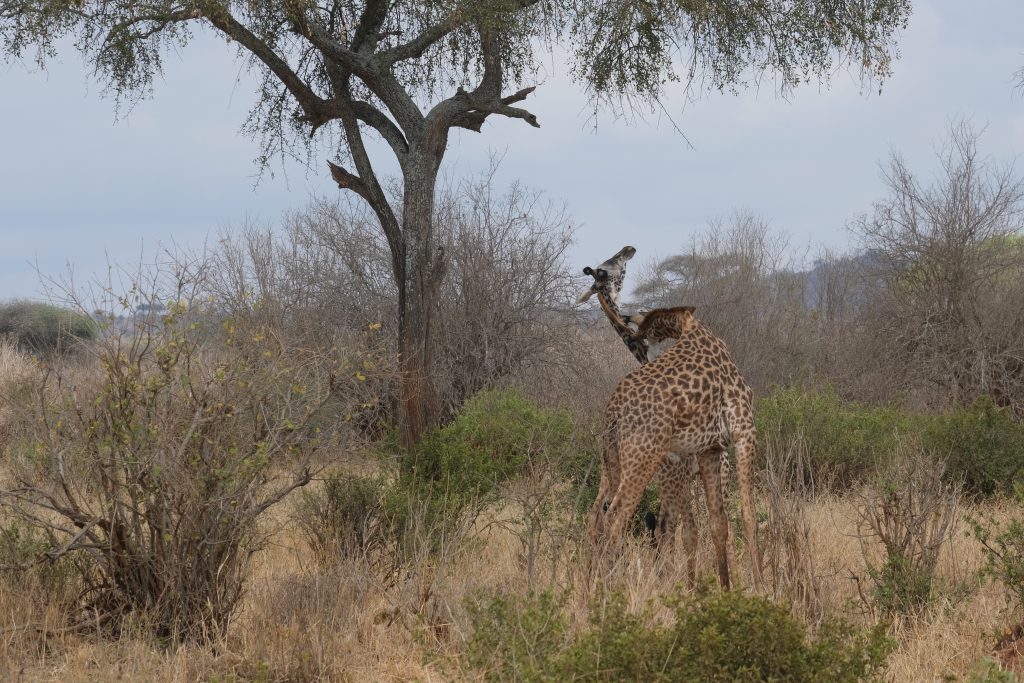
Two male giraffes fighting @Tarangire
The tender family scenes were equally captivating: mama elephants patiently teaching babies how to walk and use their trunks, a baby baboon struggling to stay balanced on its mother’s back, elephant and zebra families taking luxurious mud baths, and baby elephants playfully testing their independence.
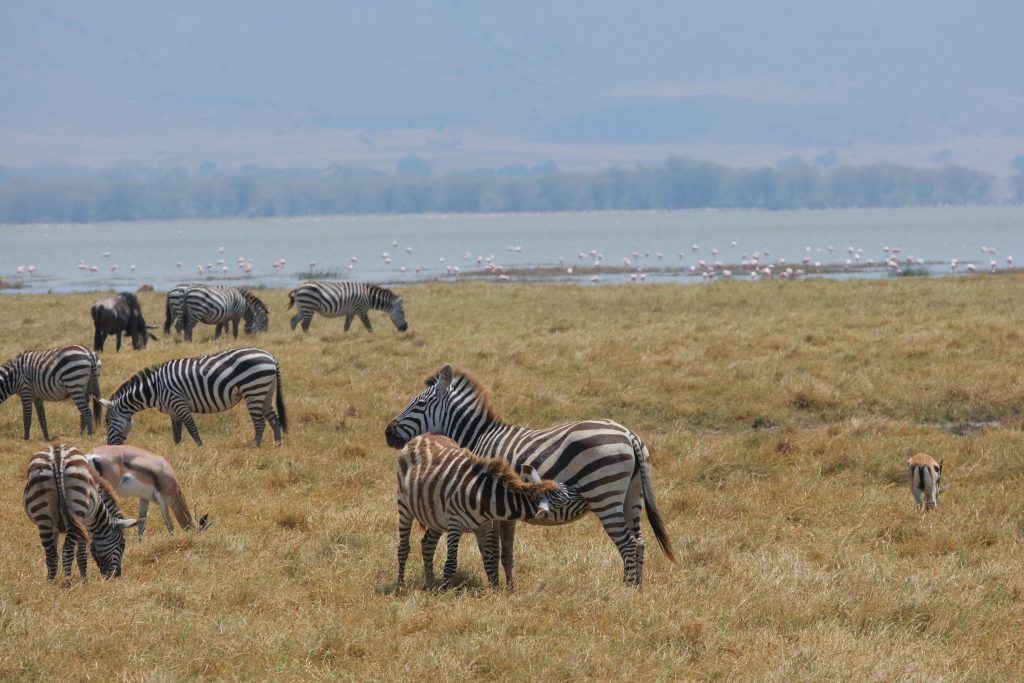
Young zebra drinking milk @Ngorogoro
The quirky, delightful moments reminded us that wildlife has personality: a male lion sulking away after being rejected by females (and relieving himself nearby), leopards lounging casually in trees like oversized house cats, ostrich courtship rituals that were both awkward and fascinating, gazelles standing in formation facing the wind while one acted as sentinel, banded mongoose moving in perfect synchronization, and yes—zebras’ undeniably cute butts.
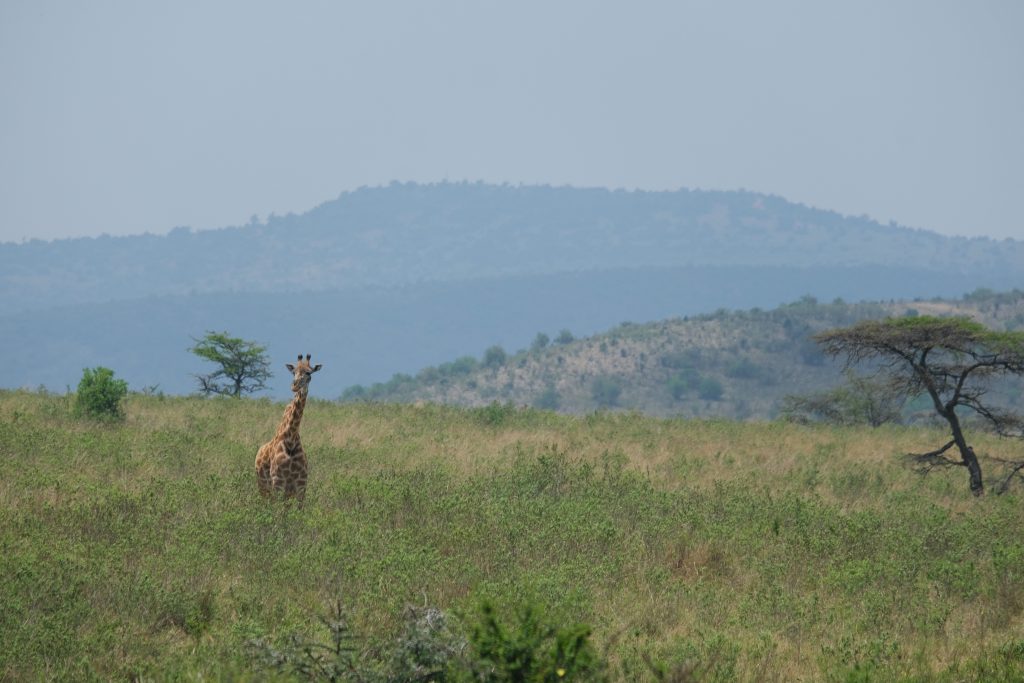
Giraffe @Central Serengeti
The heartbreaking realities of nature included that lost baby topi calling for its family, wildebeest calves separated from mothers during chaotic river crossings, an injured male hippo with blood on his hindquarters who had lost a territorial battle and now faced life alone, and the raw efficiency of predator-prey relationships that documentaries can’t fully capture.
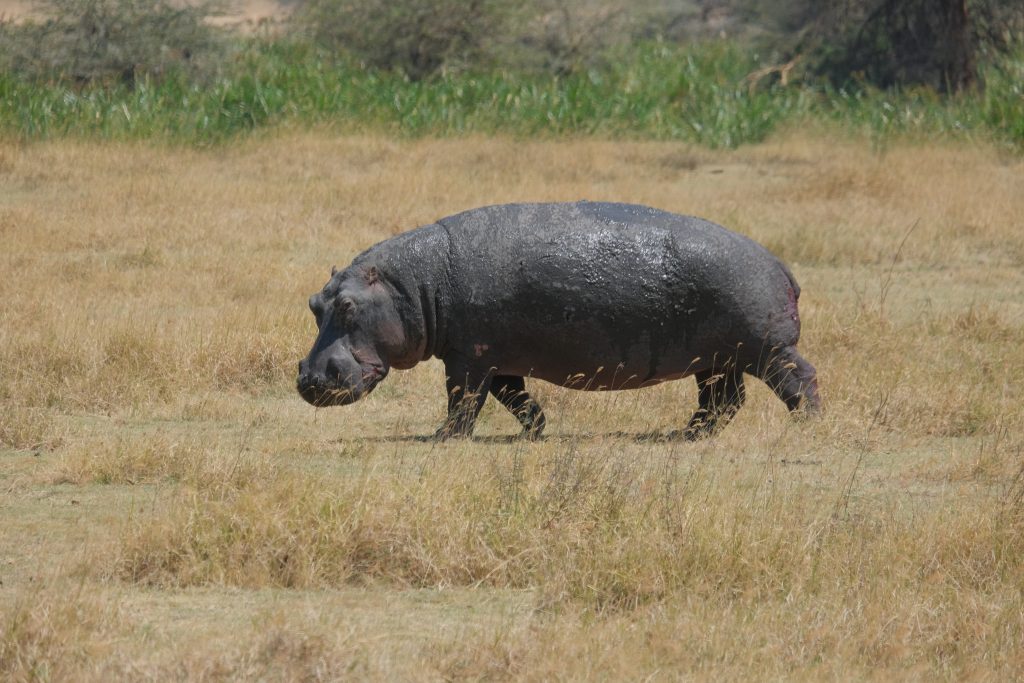
Injured hippo @Ngorongoro
The landscapes provided constant variety: endless Serengeti plains dotted with kopjes, Ngorongoro’s crater amphitheater, Tarangire’s baobab wonderland, peaceful swamps where pregnant warthogs foraged among paddling ducks, acacia trees providing shade for resting cats, and the Mara River’s dramatic crossing points.
The Great Migration itself defied comprehension—hundreds of thousands of wildebeest and zebra stretching to every horizon, moving in ancient patterns that dwarf human timescales. Standing witness to this primordial dance between animals and weather patterns felt like glimpsing the fundamental rhythms that govern life itself.
This wasn’t just a wildlife viewing trip—it was nine days of constant amazement at nature’s complexity, beauty, harshness, and humor all playing out simultaneously across Tanzania’s incredible ecosystems.
Essential Reading
Safari Companion became our most-referenced resource. Packed with mammal behavior information, it helped us understand what we were witnessing rather than just observing. Our guide constantly referred to facts from this book, making it invaluable for deeper wildlife appreciation.
Additionally, National Audubon Society Field Guide to African Wildlife works excellently as a field guide with clear pictures for species identification, habitats and geography. Our guide carried one in the vehicle.
Your Turn
If you’re wondering whether safari is worth the investment, it’s about witnessing life operating on its most fundamental level—survival, family, migration, ancient patterns that define existence itself.
Tanzania delivered everything we hoped for and more. Start planning your own journey. Choose your destination, make your decisions, and commit to witnessing something that will change how you see the world.
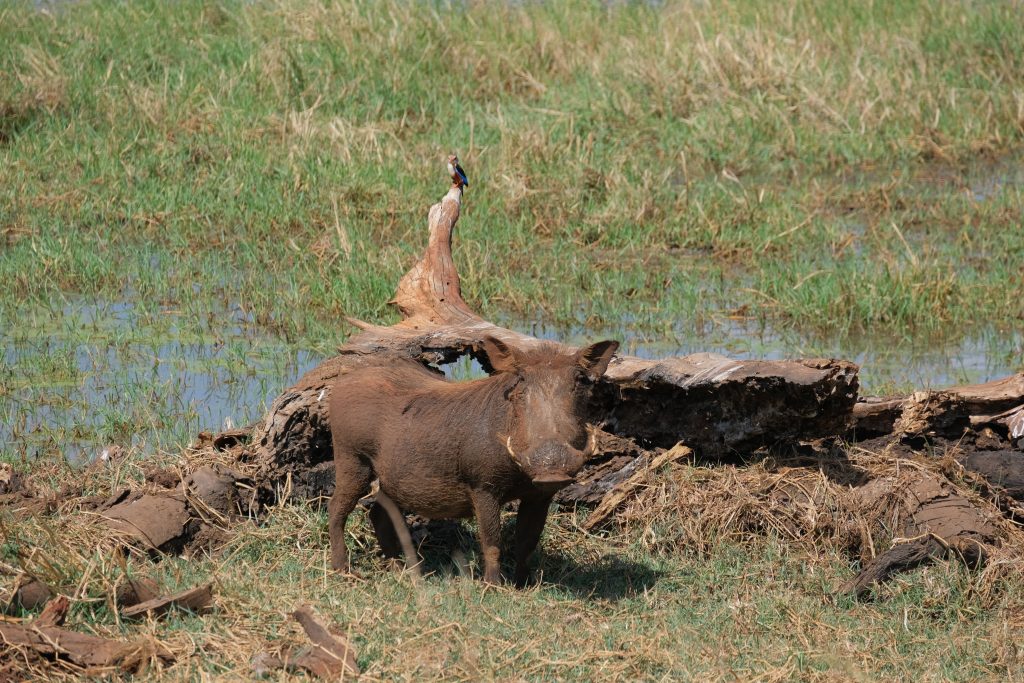
Looking at you! @Tarangire =D
Want to see more guides like this? Join my newsletter!





